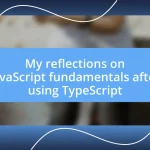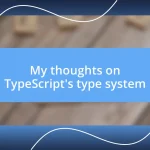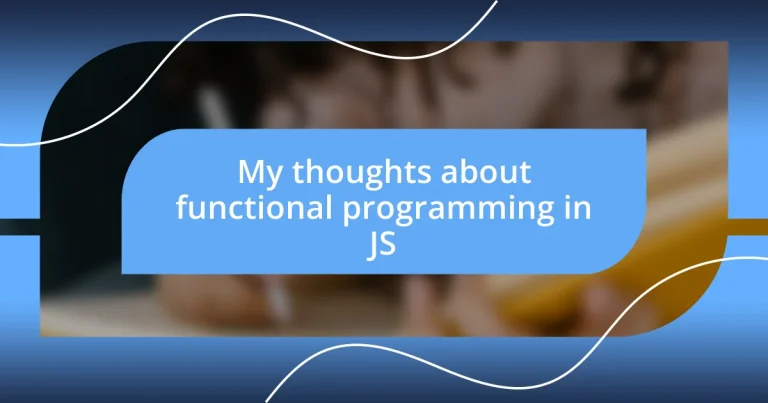Key takeaways:
- Functional programming promotes clearer, more maintainable code through principles like immutability and pure functions, reducing debugging headaches.
- Common techniques such as map, filter, and reduce allow for elegant data transformations, enhancing code readability and efficiency.
- Embracing functional programming can lead to innovative problem-solving approaches, fostering creativity and collaboration within development teams.

Understanding functional programming
Functional programming is a programming paradigm that emphasizes the use of pure functions and avoids mutable data. I remember when I first stumbled upon it; the idea of treating functions as first-class citizens was revolutionary for me. It made me rethink how I approached coding and helped me develop a deeper understanding of how to organize my logic.
What struck me the most is the concept of immutability—once you create data, you don’t change it, but rather create new data based on it. I found that this idea simplified my debugging process, as I could trace back the transformations without worrying about side effects. Have you ever experienced the frustration of a variable changing unexpectedly? With functional programming, those headaches fade away.
By leveraging functions as building blocks, functional programming fosters a clearer and more concise code structure. This approach not only enhances readability but also promotes reusability. I think about my own projects; embracing this paradigm allowed me to create components that could be reused effortlessly. Isn’t it satisfying to see code that feels almost poetic in its simplicity and elegance?

Core principles of functional programming
When I think about the core principles of functional programming, a few key concepts come to mind. It’s fascinating how this paradigm emphasizes pure functions, which means they consistently return the same output for a given input without side effects. I remember writing a script where I utilized pure functions; the predictability made my testing process so much smoother. It transformed my approach to coding—suddenly, instead of wrestling with unpredictable outcomes, I was delighting in the clarity of my logic.
Here are some core principles that define functional programming:
- Immutability: Data cannot be changed; new data is created instead.
- First-Class Functions: Functions can be passed as arguments, returned from other functions, and assigned to variables.
- Higher-Order Functions: Functions that take other functions as arguments or return them as results.
- Pure Functions: Functions that do not have side effects and return the same result given the same input.
- Function Composition: Building complex functions by combining simpler ones, which helps in modularity.
Reflecting on these principles, I love how they foster a more logical and mathematical mindset in programming. It’s like solving a puzzle, where each piece contributes to a beautiful whole. There’s something liberating about knowing that every function I write can seamlessly work with others, which gives me a sense of accomplishment as I build each layer of functionality.

Common functional programming techniques
When diving into functional programming in JavaScript, there are several common techniques that I find incredibly valuable. One of my favorites is map, which allows me to transform data seamlessly. I remember working on a project where I needed to update an array of user objects. Instead of using a loop that potentially led to mutable states, the use of map helped me create a new array, maintaining the integrity of the original. It felt like an elegant solution that not only reduced bugs but also made my intent clear at first glance.
Another technique I often use is filter, which helps in creating subsets of data based on specific criteria. Using filter is like having a focused lens on your data; I recall a time when I was working on an application that needed to display active tasks. With a simple filter function, I could return only the items that met my conditions, and it made my code feel cleaner and more intentional.
Lastly, I can’t overlook reduce, which is a powerful tool for aggregating or combining data. It reminds me of how, in my earlier days as a developer, I frequently resorted to loops for computations. However, learning reduce transformed my approach—I could condense complex operations into concise, expressive code. This transition not only simplified my logic but also gave me immense satisfaction seeing how such a small function could wield such power in organizing data.
| Technique | Description |
|---|---|
| Map | Transforms each element in an array, generating a new array with the results. |
| Filter | Creates a new array with all elements that pass the specified condition. |
| Reduce | Reduces an array to a single value by executing a reducer function on each element. |

Practical examples of functional programming
When I think about practical applications of functional programming in JavaScript, one moment stands out vividly. During a recent project, I faced the challenge of processing a large dataset of sales transactions. By leveraging the reduce function, I managed to summarize total sales efficiently. I still remember that exhilarating ‘aha’ moment when I realized I could condense multiple steps into one smooth operation, making my code not just functional but elegant.
Another practical example comes from using filter in a task management app I built. I recall receiving feedback that users wanted to see only overdue tasks. With a simple filter function, I could easily isolate those tasks without disrupting the original array. That moment reinforced my belief that functional programming makes complex requirements feel almost effortless—how refreshing is it to transform lengthy code into clean, readable commands that speak directly to our needs?
Lastly, the map function has been a game changer for me when dealing with visual data representations. I once created a data visualization dashboard where I needed to convert raw data points into formatted labels. Using map, I was able to efficiently transform each point with minimal code. Can you imagine the frustration of wrangling through loops just to achieve the same result? That clarity and precision in using functional programming keep me coming back for more—it’s like tailoring a finely fitted suit for my code!

Challenges of functional programming
When I first ventured into functional programming, I was taken aback by how it challenged my understanding of state and immutability. In traditional programming practices, I often modified states directly, but in functional programming, the mindset shifts. Can you imagine constantly reminding yourself to avoid side effects? I found it difficult at first, but the understanding of cleaner code and fewer bugs kept me motivated.
Another challenge I encountered was the steep learning curve associated with higher-order functions. While I appreciated the elegance of functions that accept other functions as parameters, wrapping my head around their usage took time. I remember grappling with callbacks and struggling to understand how to manage asynchronous operations. It felt like I was on a puzzle-solving spree, but once I found my footing, I realized the potential to create more versatile and reusable code blocks.
Lastly, I often wrestle with performance issues when applying functional programming techniques—especially when working with large datasets. One time, I implemented a series of chained functional methods like filter and map on a huge array, and the application lagged. I couldn’t help but feel a mix of disappointment and frustration, questioning whether I was sacrificing performance for the sake of elegance. It made me reflect on the balance between readability and efficiency, reminding me that while functional programming offers many benefits, it’s crucial to assess the context of its use.

Conclusion on functional programming value
Functional programming has truly transformed the way I approach JavaScript. I’ve come to appreciate its emphasis on immutability and pure functions. It’s like stepping into a world where each function is a small, manageable piece of logic that you can trust to operate without unwanted side effects. Doesn’t it feel liberating knowing you can isolate changes and predict outcomes so much more reliably?
One of the standout values of functional programming is its ability to enhance code readability and maintenance. I often receive comments from colleagues praising how streamlined our codebases have become after adopting this paradigm. I remember one specific instance when a team member remarked how much easier it was to onboard new developers. It struck me then that clear code not only improves our current workflow but also builds a foundation for future collaboration—incredible, right?
Moreover, the paradigm encourages a mindset shift that fosters creativity in problem-solving. I often find myself exploring different approaches rather than sticking to the same old methods. There was a moment when I rewrote a complicated data manipulation task using functional techniques, and it opened my eyes to new possibilities. Isn’t it exciting to think that engaging with functional programming can lead us to innovative solutions we hadn’t considered before?














